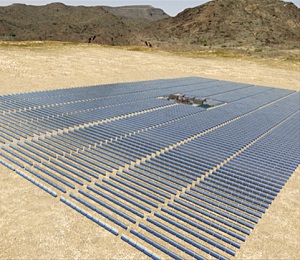DOI receives praise for final Solar PEIS ruling, allowing solar on public lands
 Today, July 24, the Department of the Interior (DOI) issued its final ruling on the Solar Programmatic Environmental Impact Statement (PEIS), a document that’s been in development for years. While the name isn’t to catchy, it’s the most significant policy piece for solar energy—and likely for conservationists this year, if not in the past couple of years.
Today, July 24, the Department of the Interior (DOI) issued its final ruling on the Solar Programmatic Environmental Impact Statement (PEIS), a document that’s been in development for years. While the name isn’t to catchy, it’s the most significant policy piece for solar energy—and likely for conservationists this year, if not in the past couple of years.
The PEIS is the finalization of DOI’s plans to allow companies to develop solar installations on lands managed by the Bureau of Land Management (BLM) in the U.S. Southwest. It includes lands in Arizona, California, Colorado, Nevada, New Mexico, and Utah, pre-identified as ideal for solar project development, known as Solar Energy Zones as well as a process for proposing projects on well-sited lands outside of the area, and a complaint procedure allowing interested parties to implement further reviews of projects outside the Solar Energy Zones.
The resulting PEIS was praised by a by collaboration of strange bedfellows ranging from developers to solar companies to environmentalists, that released a joint statement about the decision. They included: Audubon, Brightsource Energy Inc., Center for Energy Efficiency and Renewable Technologies, Center for New Energy Economy, Cleanline Partners, DBL Ventures, Defenders of Wildlife, enXco, First Solar, Inc., Greater Phoenix Economic Council, Large-scale Solar Association, Kris Mayes, former Arizona Corporation Commissioner, Natural Resources Defense Council, The Nature Conservancy, NRG Energy, Pacific Gas & Electric Company, Sierra Club, Solar Energy Industries Association, Southern California Edison, Vote Solar, The Wilderness Society.
“This document is one of the most significant policy steps forward that the DOI has ever taken. The DOI has never taken a public approach or never put in place a mitigation approach for an energy policy,” said Michael Powelson, director of Energy Programs at The Nature Conservancy. “They did a great job. For the mitigation pilots it will take a few months to develop. We probably won’t see one developed until the end of the year.” The first pilot is being developed in Nevada, he added.
Powelson doesn’t think this sort of a collaboration with the DOI has happened before. “Relative to this this sort of policy outcome…It was [the first] to my knowledge,” he said. There were some bumps along the way. “There were clearly some tensions between potential rampant solar development and the conservation community.…I would like to credit again the DOI and BLM. They put up a message that said industry and community had to work together.” He said the resulting policy will be a lot stronger since it has support from the community instead of just industry.
“This is the type of approach we would like to see DOI use for all energy development on public lands,” Powelson said. They provided a lot of acreage initially. They put a great process in place to think about new places. The environmental community and The Nature Conservancy is very happy,” he said.



